Women in the United States Senate
This article covers the history of women in the U.S. Senate and various milestones achieved by female senators. It includes a list of all women who have served in the U.S. Senate, a list of current female senators, and a list of states represented by women in the U.S. Senate. The first female U.S. senator, Rebecca Latimer Felton, represented Georgia for a single day in 1922, and the first woman elected to the U.S. Senate, Hattie Caraway, was elected from Arkansas in 1932. Fifty-eight women have served in the United States Senate since its establishment in 1789. As of January 20, 2021, there are 24 women (16 Democrats and eight Republicans) serving in the United States Senate.
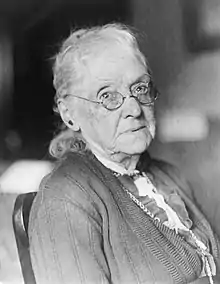
History



For its first 130 years in existence, the Senate's membership was entirely male. Until 1920, few women ran for the Senate. Until the 1990s, very few were elected. This paucity of women was due to many factors, including the lack of women's suffrage in many states until ratification of the Nineteenth Amendment to the United States Constitution, women's limited access to higher education until the mid-1900s, public perceptions of gender roles, and barriers to women's advancement such as sex discrimination.
The first woman in the U.S. Senate was Rebecca Latimer Felton, who served representing Georgia for only one day in 1922. Hattie Caraway became the first woman to win election to the Senate representing Arkansas, in 1932. Margaret Chase Smith was the first woman to serve in both the House and Senate; she first served in the House, and began serving in the Senate in 1949. Margaret Chase Smith won her 1960 race for Senate in the nation's first ever race pitting two women (her and Lucia Cormier) against each other for a Senate seat. Elaine Edwards was the first Catholic woman in the Senate, having been appointed in 1972 by her husband, the Governor of Louisiana, when she was her state's First Lady, and retired from Congress after three months. Muriel Humphrey Brown was the first and only Second Lady to serve in the United States Senate. After her husband, Hubert Humphrey, was defeated in the 1968 presidential election, he won back his old Senate seat representing Minnesota. Following his unexpected death in office, Brown was appointed by the Governor of Minnesota in 1978 to fill her late husband's Senate seat. She served for less than one year, and did not seek election.
In 1978, Nancy Kassebaum became the first woman ever elected to a full term in the Senate representing Kansas without her husband having previously served in Congress.[n 1] Since 1978, there has always been at least one woman in the Senate. The first woman to be elected to the Senate without any family connections was Paula Hawkins (R-FL), elected in 1980. She was also the first and to date only female member of The Church of Jesus Christ of Latter-day Saints elected to the United States senate. There were still few women in the Senate near the end of the 20th century, long after women began to make up a significant portion of the membership of the House. The trend of few women in the Senate began to change in the wake of the Clarence Thomas Supreme Court nomination hearings, and the subsequent election of the 103rd United States Congress in 1992, which was dubbed the "Year of the Woman".[1] In addition to Barbara Mikulski, who was reelected that year (1992), four women were elected to the Senate, all Democrats. They were Patty Murray of Washington, Carol Moseley Braun of Illinois, and Dianne Feinstein and Barbara Boxer, both of California. Carol Moseley Braun, who was African-American, was the first woman of color in the Senate. She was also the first woman to defeat an incumbent senator, winning the 1992 Democratic primary election over Alan Dixon. Later in 1992, Dianne Feinstein was the first woman to defeat an incumbent senator from a different party when she defeated John Seymour in a special election. Feinstein entered the Senate the same year as the first female Jewish senator.[2][3][4]
Bathroom facilities for women in the Senate on the Senate Chamber level were first provided in 1992.[5] Women were not allowed to wear pants on the Senate floor until 1993.[6][7] In 1993, Senators Barbara Mikulski and Carol Moseley Braun wore pants onto the floor in defiance of the rule, and female support staff followed soon after, with the rule being amended later that year by Senate Sergeant-at-Arms Martha Pope to allow women to wear pants on the floor so long as they also wore a jacket.[6][7]
The first time two female senators from the same state served concurrently was beginning in 1993; Dianne Feinstein and Barbara Boxer (both D-CA) were both elected in 1992, with Feinstein taking office that same year (as the result of a special election) and Boxer taking office in 1993 until 2016 when Boxer retired and Feinstein was joined by Kamala Harris. In June 1993, Kay Bailey Hutchison won a special election in Texas, and joined Kassebaum as a fellow female Republican senator. These additions significantly diminished the popular perception of the Senate as an exclusive "boys' club". Since 1992, there has been at least one new woman elected to the Senate every two years with the exception of the 2004 cycle (Lisa Murkowski was elected for the first time in 2004, but had been appointed to the seat since 2002). Since 2004, at least two new women have been elected to the Senate every two years, with the exceptions of 2010, when Kelly Ayotte of New Hampshire was the only new woman elected to the Senate, and 2020, when Cynthia Lummis of Wyoming was the lone newly-elected female senator.
Olympia Snowe of Maine arrived in the Senate in 1995, having previously served in the US House of Representatives and both houses of the Maine state legislature. She and later Debbie Stabenow of Michigan and Kyrsten Sinema of Arizona are the only women to have served in both houses of a state legislature and both houses of the federal legislature. In 2000, Stabenow and Maria Cantwell became the first women to defeat incumbent elected senators in a general election, unseating Senators Spencer Abraham and Slade Gorton respectively.[n 2] Hillary Clinton is the first and only First Lady to run for and/or to win a Senate seat. Clinton joined the Senate in 2001 becoming the first female senator of New York, and served until 2009 when she resigned to become the 67th United States Secretary of State under President Barack Obama. She was replaced by Kirsten Gillibrand, who has been reelected three times and was herself a candidate for president in the 2020 Democratic Party presidential primaries.
In 2008, Kay Hagan became the first woman to unseat a female incumbent, Elizabeth Dole. Upon the opening of the 112th United States Congress in 2011, New Hampshire Democrat Jeanne Shaheen was joined by newly elected Republican Kelly Ayotte, making up the first Senate delegation of two women belonging to different parties.

In 2011, Barbara Mikulski became the longest-serving woman senator in history.[8] As of 2020, she remains the longest-serving woman senator,[9] having served for 30 years.[10]
In 2012, there was a second "Year of the Woman" with the election of five women and the reelection of six women. This beat the record of four new female senators from 1992 and set the record of five new women and eleven female senators in one Senate class. The five new women were Democrats Tammy Baldwin of Wisconsin, Heidi Heitkamp of North Dakota, Mazie Hirono of Hawaii, Elizabeth Warren of Massachusetts, and Republican Deb Fischer of Nebraska. Hirono was the first Asian-American woman and first Buddhist person in the Senate, and Baldwin was the first openly gay person in the Senate.
In 2016, Hillary Clinton became the first former female senator and First Lady to win a major-party's nomination for President of the United States. Despite winning a plurality of the popular vote, she ultimately lost her bid to President Donald Trump.
Joni Ernst became the first female combat veteran to serve in the Senate when she joined in 2015. Catherine Cortez Masto, elected in 2016 was the first Latina senator.[11] In a June 2016 primary election, as a result of California's recent establishment of the top-two primary, Attorney General of California Kamala Harris and U.S. Representative Loretta Sanchez became the first women of the same party to advance to a Senate general election. In November 2016, Harris became the first woman to defeat a woman of the same party in a Senate general election. Jeanne Shaheen and Maggie Hassan, both of New Hampshire hold the distinction of being the first and second women elected both governor and senator of a state; both served as Governor of New Hampshire and served together in the Senate starting in 2017.
In 2017 Tammy Duckworth became the first female double amputee in the U.S. Senate. On April 9, 2018, Duckworth gave birth to her daughter Maile Pearl, becoming the first incumbent senator to give birth.[12] Shortly afterward, rules were changed so that a senator has the right to bring a child under one year old on the Senate floor and breastfeed them during votes.[13] The day after those rules were changed, Maile became the first baby on the Senate floor when Duckworth brought her.[13][14]
In 2018 Kyrsten Sinema defeated Martha McSally to become Arizona's first female senator, and the first openly bisexual senator from any state. Two weeks later, Arizona Governor Doug Ducey announced that he would appoint McSally to Arizona's other Senate seat, which was becoming vacant with the resignation of Jon Kyl. Sinema and McSally have been the only concurrently serving female senators to have previously faced off against each other in a Senate election. McSally exited the Senate in late 2020 after losing that year's special election to Mark Kelly, a Democrat.
Fifty-eight women have served in the United States Senate since its establishment in 1789.[15] Cumulatively, 36 female U.S. senators have been Democrats, while 22 have been Republicans. As of 2019, no female U.S. senator has ever died in office, won election to the House after her Senate term, resigned from a state governorship for the purpose of a Senate appointment by her successor, also won election as an independent or to represent more than one state in non-consecutive elections, served both seats of a state at different times, switched parties, or represented a third party in her career.
Some female U.S. senators have later run for U.S. president or vice president—see list of female United States presidential and vice-presidential candidates. In 2020, Kamala Harris became the first female senator, current or past, to win her vice-presidential election bid.
Election, selection, and family
| This article is part of a series on the |
| United States Senate |
|---|
 Great Seal of the United States Senate |
| History of the United States Senate |
| Members |
|
| Politics and procedure |
| Places |
Before 2001, a plurality of women joined the U.S. Senate through appointment following the death or resignation of a husband or father who previously held the seat. An example is Muriel Humphrey (D-MN), the widow of former senator and Vice President Hubert Humphrey; she was appointed to fill his seat until a special election was held (in which she did not run). However, with the election of three women in 2000, the balance shifted; more women have now entered service as a senator by winning elections than by being appointed.
Recent examples of selection include Jean Carnahan and Lisa Murkowski. In 2000, Jean Carnahan (D-MO) was appointed to fill the Senate seat won by her recently deceased husband, Mel Carnahan. Carnahan—even though dead—defeated the incumbent senator, John Ashcroft. Carnahan's widow was named to fill his seat by Missouri Governor Roger Wilson until a special election was held. However, she lost the subsequent 2002 election to fill out the rest of the six-year term. In 2002, Lisa Murkowski (R-AK) was appointed by her father Alaska Governor Frank Murkowski, who had resigned from the Senate to become governor, to serve the remaining two years of his term. Lisa Murkowski defeated former governor Tony Knowles in her retention bid in 2004.
Two recent members of the Senate brought with them a combination of name recognition resulting from the political careers of their famous husbands and their own substantial experience in public affairs. The first, former senator Elizabeth Dole (R-NC), is married to former Senate Majority Leader and 1996 Republican presidential candidate Bob Dole and served as Secretary of Transportation under President Ronald Reagan and Secretary of Labor under President George H. W. Bush; she later ran a losing bid for the Republican presidential nomination in 2000. The other, former senator Hillary Clinton (D-NY), wife of former President Bill Clinton, was First Lady of the United States and First Lady of Arkansas before taking her seat in 2000. She too ran an unsuccessful campaign for her party's presidential nomination in 2008; she resigned in 2009 to become the secretary of state for the eventual victor of that election, Barack Obama. In 2016, she ran a successful campaign for her party's presidential nomination, eventually losing in the general election to Republican nominee Donald Trump.
Another famous name is Nancy Landon Kassebaum (R-KS), the daughter of former Kansas governor and one-time presidential candidate Alf Landon. After retiring from the Senate, she married former senator Howard Baker (R-TN). Kassebaum has the distinction of being the first female elected senator who did not succeed her husband in Congress (Margaret Chase Smith was only elected to the Senate after succeeding her husband to his House seat).
Among the women elected or selected in Senate history, by stature, Barbara Mikulski (D-MD) is the shortest at 5 feet (1.52 m), whereas Kelly Loeffler (R-GA) is the tallest at 5 feet 11 inches (1.80 m).[16][17]
List of female U.S. senators in history
| Portrait | Name (lifespan) |
State | Term start | Term end | Length of service (days) |
Entered by | Left for | Party |
|---|---|---|---|---|---|---|---|---|
 |
Rebecca Felton (1835–1930) |
November 21, 1922 | November 22, 1922 | 1 (1 day) |
Appointment by Thomas W. Hardwick | Appointment ended | Democratic | |
.jpg.webp) |
Hattie Caraway (1878–1950) |
December 9, 1931 | January 3, 1945 | 4,774 (13 years, 25 days) |
Appointment by Harvey Parnell | Lost renomination | Democratic | |
 |
Rose Long (1892–1970) |
January 31, 1936 | January 3, 1937 | 338 (338 days) |
Appointment by James Noe | Appointment ended | Democratic | |
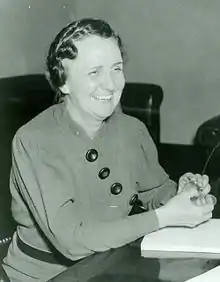 |
Dixie Graves (1882–1965) |
August 20, 1937 | January 10, 1938 | 143 (143 days) |
Appointment by Bibb Graves | Appointment ended | Democratic | |
 |
Gladys Pyle (1890–1989) |
November 9, 1938 | January 3, 1939 | 55 (55 days) |
Special election | Retired | Republican | |
.jpg.webp) |
Vera C. Bushfield (1889–1976) |
October 6, 1948 | December 26, 1948 | 81 (81 days) |
Appointment by George Mickelson | Appointment ended | Republican | |
 |
Margaret Chase Smith (1897–1995) |
January 3, 1949 | January 3, 1973 | 8,766 (24 years, 0 days) |
Election | Lost reelection | Republican | |
 |
Eva Bowring (1892–1985) |
April 16, 1954 | November 7, 1954 | 205 (205 days) |
Appointment by Robert B. Crosby | Appointment ended | Republican | |
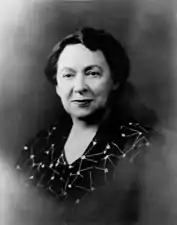 |
Hazel Abel (1888–1966) |
November 8, 1954 | December 31, 1954 | 53 (53 days) |
Special election | Retired and resigned early[n 3] | Republican | |
 |
Maurine Neuberger (1907–2000) |
November 9, 1960 | January 3, 1967 | 2,246 (6 years, 55 days) |
Special election | Retired | Democratic | |
.jpg.webp) |
Elaine Edwards (1929–2018) |
August 1, 1972 | November 13, 1972 | 104 (104 days) |
Appointment by Edwin Edwards | Appointment ended | Democratic | |
.jpg.webp) |
Muriel Humphrey (1912–1998) |
January 25, 1978 | November 7, 1978 | 286 (286 days) |
Appointment by Rudy Perpich | Appointment ended | Democratic (DFL) | |
 |
Maryon Allen (1925–2018) |
June 8, 1978 | November 7, 1978 | 152 (152 days) |
Appointment by George Wallace | Lost nomination to finish term | Democratic | |
 |
Nancy Kassebaum (born 1932) |
December 23, 1978 | January 3, 1997 | 6,586 (18 years, 11 days) |
Election[n 4] | Retired | Republican | |
 |
Paula Hawkins (1927–2009) |
January 1, 1981 | January 3, 1987 | 2,193 (6 years, 2 days) |
Election[n 4] | Lost reelection | Republican | |
 |
Barbara Mikulski (born 1936) |
January 3, 1987 | January 3, 2017 | 10,959 (30 years, 0 days) |
Election | Retired | Democratic | |
 |
Jocelyn Burdick (1922–2019) |
September 16, 1992 | December 14, 1992 | 89 (89 days) |
Appointment by George Sinner | Appointment ended | Democratic-NPL | |
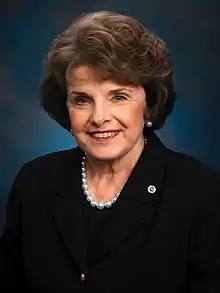 |
Dianne Feinstein (born 1933) |
November 10, 1992 | present | 10,318 (28 years, 91 days) |
Special election | Incumbent | Democratic | |
 |
Barbara Boxer (born 1940) |
January 3, 1993 | January 3, 2017 | 8,767 (24 years, 0 days) |
Election | Retired | Democratic | |
 |
Carol Moseley-Braun (born 1947) |
January 3, 1993 | January 3, 1999 | 2,191 (6 years, 0 days) |
Election | Lost reelection | Democratic | |
 |
Patty Murray (born 1950) |
January 3, 1993 | present | 10,264 (28 years, 37 days) |
Election | Incumbent | Democratic | |
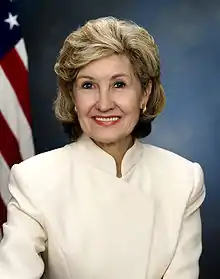 |
Kay Hutchison (born 1943) |
June 14, 1993 | January 3, 2013 | 7,143 (19 years, 203 days) |
Special election | Retired | Republican | |
 |
Olympia Snowe (born 1947) |
January 3, 1995 | January 3, 2013 | 6,576 (18 years, 0 days) |
Election | Retired | Republican | |
.jpg.webp) |
Sheila Frahm (born 1945) |
June 11, 1996 | November 6, 1996 | 148 (148 days) |
Appointment by Bill Graves | Lost nomination to finish term | Republican | |
 |
Susan Collins (born 1952) |
January 3, 1997 | present | 8,803 (24 years, 37 days) |
Election | Incumbent | Republican | |
 |
Mary Landrieu (born 1955) |
January 3, 1997 | January 3, 2015 | 6,575 (18 years, 0 days) |
Election | Lost reelection | Democratic | |
 |
Blanche Lincoln (born 1960) |
January 3, 1999 | January 3, 2011 | 4,383 (12 years, 0 days) |
Election | Lost reelection | Democratic | |
 |
Maria Cantwell (born 1958) |
January 3, 2001 | present | 7,342 (20 years, 37 days) |
Election | Incumbent | Democratic | |
 |
Jean Carnahan (born 1933) |
January 3, 2001 | November 25, 2002 | 691 (1 year, 326 days) |
Appointment by Roger B. Wilson | Lost election to finish term | Democratic | |
 |
Hillary Clinton (born 1947) |
January 3, 2001 | January 21, 2009 | 2,940 (8 years, 18 days) |
Election | Resigned to become United States Secretary of State | Democratic | |
 |
Debbie Stabenow (born 1950) |
January 3, 2001 | present | 7,342 (20 years, 37 days) |
Election | Incumbent | Democratic | |
 |
Lisa Murkowski (born 1957) |
December 20, 2002 | present | 6,626 (18 years, 51 days) |
Appointment by Frank Murkowski | Incumbent | Republican | |
 |
Elizabeth Dole (born 1936) |
January 3, 2003 | January 3, 2009 | 2,192 (6 years, 0 days) |
Election | Lost reelection[n 5] | Republican | |
 |
Amy Klobuchar (born 1960) |
January 3, 2007 | present | 5,151 (14 years, 37 days) |
Election | Incumbent | Democratic (DFL) | |
 |
Claire McCaskill (born 1953) |
January 3, 2007 | January 3, 2019 | 4,383 (12 years, 0 days) |
Election | Lost reelection | Democratic | |
 |
Jeanne Shaheen (born 1947) |
January 3, 2009 | present | 4,420 (12 years, 37 days) |
Election | Incumbent | Democratic | |
 |
Kay Hagan (1953–2019) |
January 3, 2009 | January 3, 2015 | 2,191 (6 years, 0 days) |
Election[n 5] | Lost reelection | Democratic | |
 |
Kirsten Gillibrand (born 1966) |
January 26, 2009 | present | 4,397 (12 years, 14 days) |
Appointment by David Paterson | Incumbent | Democratic | |
 |
Kelly Ayotte (born 1968) |
January 3, 2011 | January 3, 2017 | 2,192 (6 years, 0 days) |
Election | Lost reelection | Republican | |
 |
Tammy Baldwin (born 1962) |
January 3, 2013 | present | 2,959 (8 years, 37 days) |
Election | Incumbent | Democratic | |
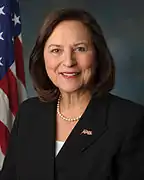 |
Deb Fischer (born 1951) |
January 3, 2013 | present | 2,959 (8 years, 37 days) |
Election | Incumbent | Republican | |
 |
Heidi Heitkamp (born 1955) |
January 3, 2013 | January 3, 2019 | 2,191 (6 years, 0 days) |
Election | Lost reelection | Democratic-NPL | |
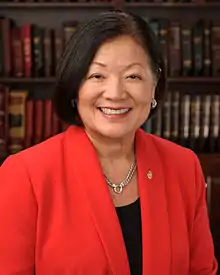 |
Mazie Hirono (born 1947) |
January 3, 2013 | present | 2,959 (8 years, 37 days) |
Election | Incumbent | Democratic | |
 |
Elizabeth Warren (born 1949) |
January 3, 2013 | present | 2,959 (8 years, 37 days) |
Election | Incumbent | Democratic | |
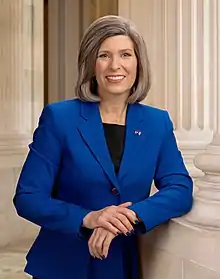 |
Joni Ernst (born 1970) |
January 3, 2015 | present | 2,229 (6 years, 37 days) |
Election | Incumbent | Republican | |
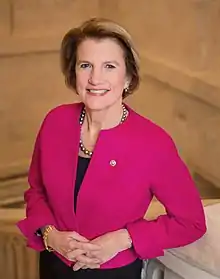 |
Shelley Moore Capito (born 1953) |
January 3, 2015 | present | 2,229 (6 years, 37 days) |
Election | Incumbent | Republican | |
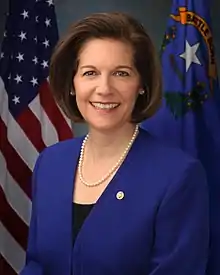 |
Catherine Cortez Masto (born 1964) |
January 3, 2017 | present | 1,498 (4 years, 37 days) |
Election | Incumbent | Democratic | |
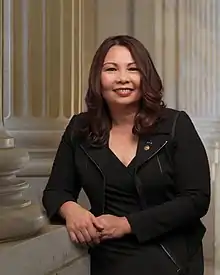 |
Tammy Duckworth (born 1968) |
January 3, 2017 | present | 1,498 (4 years, 37 days) |
Election | Incumbent | Democratic | |
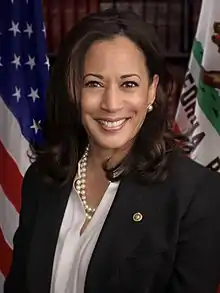 |
Kamala Harris (born 1964) |
January 3, 2017 | January 18, 2021 | 1,476 (4 years, 15 days) |
Election | Resigned to become Vice President of the United States | Democratic | |
 |
Maggie Hassan (born 1958) |
January 3, 2017 | present | 1,498 (4 years, 37 days) |
Election | Incumbent | Democratic | |
 |
Tina Smith (born 1958) |
January 3, 2018 | present | 1,133 (3 years, 37 days) |
Appointment by Mark Dayton | Incumbent | Democratic (DFL) | |
.jpg.webp) |
Cindy Hyde-Smith (born 1959) |
April 9, 2018 | present | 1,037 (2 years, 306 days) |
Appointment by Phil Bryant | Incumbent | Republican | |
 |
Marsha Blackburn (born 1952) |
January 3, 2019 | present | 768 (2 years, 37 days) |
Election | Incumbent | Republican | |
.jpg.webp) |
Kyrsten Sinema (born 1976) |
January 3, 2019 | present | 768 (2 years, 37 days) |
Election | Incumbent | Democratic | |
 |
Martha McSally (born 1966) |
January 3, 2019 | December 2, 2020 | 699 (1 year, 334 days) |
Appointment by Doug Ducey | Lost election to finish term | Republican | |
 |
Jacky Rosen (born 1957) |
January 3, 2019 | present | 768 (2 years, 37 days) |
Election | Incumbent | Democratic | |
 |
Kelly Loeffler (born 1970) |
January 6, 2020 | January 20, 2021 | 380 (1 year, 14 days) |
Appointment by Brian Kemp | Lost election to finish term | Republican | |
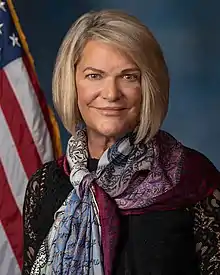 |
Cynthia Lummis (born 1954) |
January 3, 2021 | present | 37 (37 days) |
Election | Incumbent | Republican |
Currently serving women U.S. senators
At the start of the 117th Congress on January 3, 2021, there were 26 women serving in the United States Senate. This is the highest number of women to have served concurrently in the Senate in U.S. history. Seventeen of the 26 were Democrats, while nine were Republicans.[18] Since January 20, 2021, there have been 24 women serving in the United States Senate; sixteen are Democrats, and eight are Republicans.[19]
In January 2018, after the appointment of Democrat Tina Smith of Minnesota to the U.S. Senate to fill the vacancy created by the resignation of Al Franken, and in April 2018 after the appointment of Republican Cindy Hyde-Smith of Mississippi to the U.S. Senate to fill the vacancy created by the resignation of Thad Cochran, the number reached 23. In January 2019, four new women senators (Blackburn, McSally, Rosen, and Sinema) were seated although two women senators (Heitkamp and McCaskill) lost reelection bids, so the number of female senators increased to 25, with 17 being Democrats and 8 being Republicans. In January 2020, Kelly Loeffler was appointed to the Senate from Georgia, increasing the number of women in the Senate to 26, the highest proportion of women serving as U.S. senators in history.
Martha McSally lost an election to finish John McCain's unexpired term on November 3, 2020, and left the Congress on December 2, which reduced the number of female senators to 25. On January 3, 2021, Cynthia Lummis, the first woman senator from Wyoming, began her term, so the number of female senators reached 26 once again. Meanwhile, Kamala Harris was elected Vice President of the United States; she resigned her Senate seat on January 18, 2021 in anticipation of the scheduled commencement of her term as Vice President (and thus President of the Senate) on January 20, which reduced the number of female senators to 25. In addition, Loeffler lost the January 5, 2021 special election runoff for the remainder of the term to which she had been appointed, and she left office on January 20, which further reduced the number of women serving in the Senate to 24.
As of January 2021, four states (Minnesota, Nevada, New Hampshire, and Washington) are represented by two female U.S. senators.
List of states represented by women
Thirty-three states have been represented by female senators. As of January 2021, 20 are represented by female senators.
Graphs
Histograph
| Starting | Total | Graph |
|---|---|---|
| March 4, 1789 | 0 | |
| November 21, 1922 | 1 | * |
| November 23, 1922 | 0 | |
| December 9, 1931 | 1 | * |
| January 31, 1936 | 2 | ** |
| January 3, 1937 | 1 | * |
| August 20, 1937 | 2 | ** |
| January 11, 1938 | 1 | * |
| November 9, 1938 | 2 | ** |
| January 3, 1939 | 1 | * |
| January 3, 1945 | 0 | |
| October 6, 1948 | 1 | * |
| December 27, 1948 | 0 | |
| January 3, 1949 | 1 | * |
| April 16, 1954 | 2 | ** |
| January 1, 1955 | 1 | * |
| November 9, 1960 | 2 | ** |
| January 3, 1967 | 1 | * |
| August 1, 1972 | 2 | ** |
| November 14, 1972 | 1 | * |
| January 3, 1973 | 0 | |
| January 25, 1978 | 1 | * |
| June 8, 1978 | 2 | ** |
| November 8, 1978 | 0 | |
| December 23, 1978 | 1 | * |
| January 1, 1981 | 2 | ** |
| September 16, 1992 | 3 | *** |
| November 10, 1992 | 4 | **** |
| December 15, 1992 | 3 | *** |
| January 3, 1993 | 6 | ****** |
| June 14, 1993 | 7 | ******* |
| January 3, 1995 | 8 | ******** |
| June 11, 1996 | 9 | ********* |
| November 7, 1996 | 8 | ******** |
| January 3, 1997 | 9 | ********* |
| January 3, 2001 | 13 | ************* |
| November 26, 2002 | 12 | ************ |
| December 20, 2002 | 13 | ************* |
| January 3, 2003 | 14 | ************** |
| January 3, 2007 | 16 | **************** |
| January 3, 2009 | 17 | ***************** |
| January 22, 2009 | 16 | **************** |
| January 26, 2009 | 17 | ***************** |
| January 3, 2013 | 20 | ******************** |
| January 3, 2017 | 21 | ********************* |
| January 3, 2018 | 22 | ********************** |
| April 9, 2018 | 23 | *********************** |
| January 3, 2019 | 25 | ************************* |
| January 6, 2020 | 26 | ************************** |
| December 2, 2020 | 25 | ************************* |
| January 3, 2021 | 26 | ************************** |
| January 18, 2021 | 25 | ************************* |
| January 20, 2021 | 24 | ************************ |
Time series

Concurrently serving women from the same state
On January 3, 2019, Arizona's Kyrsten Sinema and Martha McSally became the first women from the same state to start serving in the Senate on the same date.
| State | Start date | End date | Duration | Senior senator | Junior senator | ||
|---|---|---|---|---|---|---|---|
| California | January 3, 1993 | January 18, 2021 | 10,242 days (28 years, 15 days) |
Dianne Feinstein (D) | Barbara Boxer (D) (January 3, 1993–January 3, 2017), 8,766 days (24 years, 0 days) | ||
| Kamala Harris (D) (January 3, 2017–January 18, 2021), 1,476 days (4 years, 15 days) | |||||||
| Kansas | June 11, 1996 | November 6, 1996 | 148 days | Nancy Kassebaum (R) | Sheila Frahm (R) | ||
| Maine | January 3, 1997 | January 3, 2013 | 5,844 days (16 years, 0 days) |
Olympia Snowe (R) | Susan Collins (R) | ||
| Washington | January 3, 2001 | present | 7,342 days (20 years, 37 days) |
Patty Murray (D) | Maria Cantwell (D) | ||
| New Hampshire | January 3, 2011 | present | 3,690 days (10 years, 37 days) |
Jeanne Shaheen (D) | Kelly Ayotte (R) (January 3, 2011–January 3, 2017), 2,192 days (6 years, 0 days) | ||
| Maggie Hassan (D) (January 3, 2017–present), 1,498 days (4 years, 37 days) | |||||||
| Minnesota | January 3, 2018 | present | 1,133 days (3 years, 37 days) |
Amy Klobuchar (D) | Tina Smith (D) | ||
| Nevada | January 3, 2019 | present | 768 days (2 years, 37 days) |
Catherine Cortez Masto (D) | Jacky Rosen (D) | ||
| Arizona | January 3, 2019 | December 2, 2020 | 699 days (1 year, 334 days) |
Kyrsten Sinema (D) | Martha McSally (R) | ||
See also
Notes
- Of the female senators who preceded Kassebaum: Rebecca Latimer Felton, Rose McConnell Long, Dixie Bibb Graves, Vera C. Bushfield, Eva Bowring, Elaine S. Edwards, Muriel Humphrey, and Maryon Pittman Allen were all appointed and were never elected; Gladys Pyle (R-SD) and Hazel Abel (R-NE), were elected, but not to full terms (i.e., to complete terms where the previous senator had died or resigned, not to new six-year terms); Hattie Caraway and Maurine Brown Neuberger were both elected to full six-year terms, but their husbands had held the seat previously. Margaret Chase Smith's (R-ME) husband never served in the Senate, but he did serve in the House. When he died, Margaret won the ensuing election. Of the appointed senators, Long, Bushfield, Humphrey, and Allen were all appointed to fill out part of the terms of their deceased husbands, while Graves and Edwards were appointed by their husbands, the governor of their states at the time. However, Kassebaum's father was a former governor of Kansas, which means that the first woman to be elected to the Senate without any family connections was Paula Hawkins, elected in 1980 to represent Florida.
- Bob Krueger and John F. Seymour, defeated by Kay Bailey Hutchison and Dianne Feinstein respectively, were appointed to the Senate by the governors of their states.
- Abel resigned 3 days before the end of her term, a common practice to give her successor seniority advantage.
- Predecessor resigned early to give successor seniority advantage, so the senator was appointed for the few days prior to the commencement of the elected term
- When Kay Hagan defeated Elizabeth Dole, it was the first time in history a woman candidate defeated an incumbent woman.
References
- "Year of the Woman". U.S. Senate.
- "Jewesses in politics represent!". Jewish Women's Archive. November 5, 2002. Retrieved April 27, 2018.
- "Dianne Feinstein". Congress.gov. Retrieved April 27, 2018.
- "Barbara Boxer". Congress.gov. Retrieved April 27, 2018.
- Plaskow, Judith (July 8, 2008). "Embodiment, Elimination, and the Role of Toilets in Struggles for Social Justice". Cross Currents. 58 (1): 51–64. doi:10.1111/j.1939-3881.2008.00004.x.
- Robin Givhan (January 21, 2004). "Moseley Braun: Lady in red". Chicago Tribune. Retrieved July 30, 2014.
- Cooper, Kent (June 9, 2005). "The Long and Short of Capitol Style : Roll Call Special Features 50th Anniversary". Rollcall.com. Retrieved July 30, 2014.
- Franke-Ruta, Garance (January 5, 2011). "Barbara Mikulski Becomes Longest-Serving Female Senator". The Atlantic.
- Gaines, Danielle E. (December 17, 2020). "Capitol Meeting Room Named in Honor of Maryland's First Female U.S. Senator". Maryland Matters.
- Schwartzman, Paul (December 12, 2016). "Passing the torch: Mikulski says goodbye to the Senate". The Washington Post.
- "U.S. Senate: Senators, 1789 to present". senate.gov. Retrieved April 8, 2018.
- "Tammy Duckworth Becomes First U.S. Senator To Give Birth While In Office". NPR.org. Retrieved April 9, 2018.
- Serfaty, Sunlen (April 18, 2018). "Babies now allowed on Senate floor after rule change". CNN.
- "A duckling onesie and a blazer: The Senate floor sees its first baby, but many traditions stand". The Washington Post. April 19, 2018. Retrieved April 20, 2018.
- "Women in the U.S. Senate 1922–2015" (PDF). Center for American Women and Politics. Archived from the original (PDF) on July 3, 2015.
- Bumiller, Elisabeth (April 29, 1984). "Four Possible Candidates". The Washington Post.
- "Risk, hoops memories entice new Dream owner Loeffler". AJC. December 3, 2019. Retrieved December 1, 2020.
A skinny 5-foot-11, her nickname on the court was NBC — 'Newborn Calf.'
- Spencer, Erin (November 5, 2020). "Record Number Of Women To Serve In The 117th U.S. Congress". Forbes. Retrieved January 26, 2021. For the Senate, the Forbes article counted o25 women and eight Republicans because the runoff election in Georgia involving Kelly Loeffler was not yet held at the time of writing.
- "New Senators Warnock, Padilla, Ossoff Add Diversity to Chamber". Bloomberg Law. January 21, 2021.
External links
- U.S. Senate History: Women in the Senate
- "Women in the U.S. Senate 1922–2010" Center for American Women and Politics, Eagleton Institute of Politics, Rutgers, The State University of New Jersey
- Steinhauer, Jennifer (March 21, 2013). "Once Few, Women Hold More Power in Senate". The New York Times. Retrieved March 23, 2013.
- Maurer, Elizabeth. "Legislating History: 100 Years of Women in Congress". National Women's History Museum. 2017.